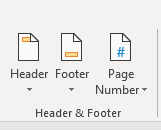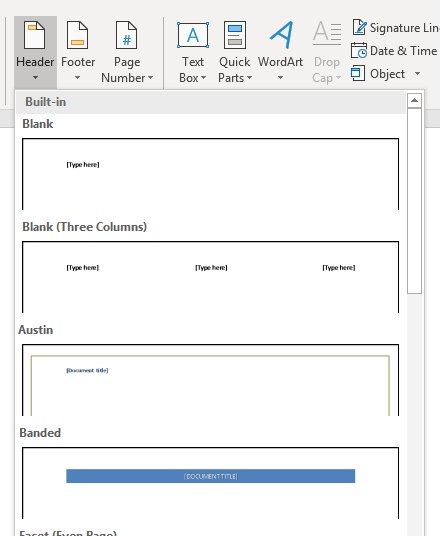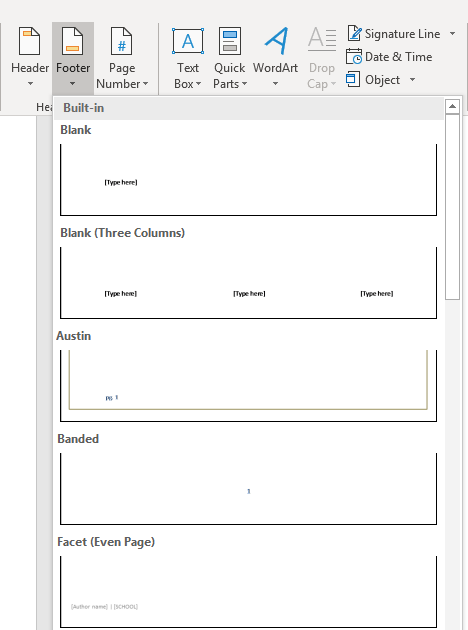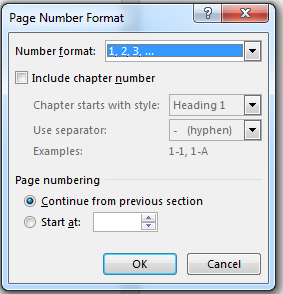
Microsoft Word gives you the option to place a header and footer at the top and bottom of your pages. You can place anything in this section, but Word uses header and footer information in all pages. You can use these settings to create titles above your pages and page numbers at the bottom of your pages.
Header and Footer Buttons
The header and footer settings buttons are in the "Insert" tab. Click the tab and find the "Header & Footer" category located in the tab.

(Header and footer buttons)
The arrows under each button indicate that clicking it will display a set of options. Headers are generally reserved for leaving titles at the top of pages. When you read a paper novel, you see the book's title at the top of a page. Some books have the chapter name at the top of a page. This is what a header does in a Word document.
Footers are generally used for information regarding page numbers or information that you want to mark at the bottom of each page. If you choose to add page numbers to the bottom of your pages in a footer setting, Word will automatically increment each page number. You don't need to manually type a page number in each footer. Word knows that a page number setting should display the page number.
In this lesson, we'll discuss header and footer configurations to customize long documents with several sections, chapters and pages.
Setting a Word Document Header
When you click the "Header" button, Word opens another window asking if you want to create a header for your document. If you click the button a second time, a list of preset header configurations is shown in a dropdown list.

(Header options dropdown styles)
You can add any one of these header options to the document, and Word will automatically format it using the style shown in the example. Choose the "Banded" option and notice that a header is added to the top of the currently active page.

(Header added to document)
After you choose a header style, it's shown at the top of the current page with a tab at the bottom-left corner that says "Header." Whenever you type any content in a document header, Word automatically displays this tab to let you know that the content you're adding to the document is the header and not the body of the page.
Word displays a prompt where you can type your custom header. In the image above, the template location is labeled "Title." Remember that headers are generally used for titles that will be displayed on every page, so typing content in the header template will be shown in each page as static content. When you add static content to a header or footer, this same content persists across all pages. Not only does the content remain the same, but the style also persists across all pages.
In the image above, the title "Test Document" is added to the header. The content is set at all capital letters due to the style presets created by Word. You can still customize header settings, but any changes that you make will affect all pages in your file. To test the new header settings, add a new page to the document.
Before you add a page break, click the document body. Notice that the "Header" tab disappears, and you're returned to the page body as the active part of the document. To add a page break, go to the "Pages" category in the "Insert" tab. Click the "Page Break" button and a new page is added to the document. Depending on the view layout, you see a new page added to the right or to the bottom of the current page. Notice that the header persists, and you see the same text and style in the footer of the new page.
Creating Footer Settings
Headers give you the benefit of adding static content at the top of your pages, but footers are usually reserved for content that changes from page to page. Most commonly, footers contain page numbers. Word supports a number of preset footer styles. You can place a page number to the left, center or right of the page. Word also supports styles that make footer settings more attractive than just having a number at the bottom of a page.
The "Footer" button is located next to the "Header" button, and clicking it displays the same action. A dropdown list of styles is displayed where you can choose the one that you prefer for your document.

(Footer dropdown options)
You'll notice that several footer options and styles are the same as the options displayed for the header dropdown. These preset styles can be added to your footer so that you don't need to create one on your own.
The most common footer is page numbers. In the footer dropdown options, you can see the page number examples with the styles applied so that you can sample what your footer will look like.
A better option to create a page number in a footer is using the "Page Number" Word function. Next to the "Footer" button is the "Page Number" button. Click this button and then choose a location for the page number. In this example, the bottom of the page is chosen. Then, choose a style and location for the page number. In this example, the right side of the bottom of the page is chosen, and Word opens the footer and places a page number to the right side of the page.

(Page number footer added to a document)
Similar to the "Header" tab that displays when you edit the header section, Word displays a "Footer" tab as you change the content in a footer. This lets you know that you aren't editing the body of a document but rather the footer. Notice in the image above that the page number "2" displays. This number is automatically generated based on the page where it's displayed.
If you look at the first page in your document, you'll notice that the page number is "1." You can test the footer feature by adding a new page break on page two. A new page is created, and at the bottom of the page will show the number "3." Word takes care of the page numbers, so should you add or delete a page in your document, the numbers will reflect the right page.
You can further format page numbers by clicking the "Page Number" button again and selecting "Format Page Numbers." This selection opens a configuration window.

(Page Number Format configuration window)
It's standard to start page number counts on page two, and this window lets you configure at which page the first number displays. You can start at any page, but it's common to start after the table of contents if you have a large document. You can also change the number format from the top dropdown. For instance, you can use roman numerals as page numbers.
You can also include chapter numbers if you're creating an ebook or a large document that has a table of contents. These footer configurations help customize the way Word displays page numbers and other information across the document.
Setting headers and footers is common for large documents, and you'll use this feature often when you create long documents. We'll cover creating a table of contents in later chapters, which is another useful tool that Word offers that will automatically generate organizational information for documentation.




























